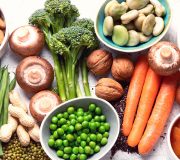A common staple item found in most freezers across America, peas are among the most popular vegetables worldwide. Peas are technically legumes (pulses), along with beans and lentils, which have enjoyed a recent resurgence as more people appreciate the merits of a whole food, plant-focused diet.
Peas themselves usually get all the attention, but there are other parts of Pisum sativum that also offer health benefits. In fact, unlike other pulses, all parts of the pea plant are edible and contain important nutrients and phytonutrients. Aside from the peas, pea pods (known as pericarps) are also edible and delicious, as well as pea vines and their leaves. Often called pea shoots or pea tendrils, young pea vines are prized in the culinary world due to their grassy, pea-like flavor, and brief window of springtime availability.
Each part of the pea plant has its own mix of nutrients and health benefits, which is why it is worth taking a broader look at peas and the entire pea-yielding plant.
Peas
Peas are miniature marvels with features all their own. Their main phytonutrient is quercetin, an important flavonoid antioxidant. Despite being a legume, their nutritional profile is such that they can be incorporated into a “paleo” diet because they are lower in phytates and lectins than other legumes, high in fiber, and contain resistant starch that helps keep post-prandial blood sugar levels steady. But that is not all:
- Peas are a great source of highly digestible protein and are high in glutamine, an important amino acid for gut health and muscle recovery.
- Considered a methylation-supportive food, peas are high in folate, magnesium, phosphorus, potassium, and trace minerals.
- Potassium and phosphorus found in peas also make it supportive of bone health.
- The combination of peas’ resistant starch and fiber make it supportive of healthy blood sugar control and encourages a healthy glycemic response, making peas an appropriate starchy vegetable choice for people with diabetes.
- Peas may also support digestive health and the intestinal microbiota by acting as a prebiotic. Eating peas may increase short chain fatty acid levels, which support gut barrier function, digestive health, and the immune system.1-2
Pea Pods
If you’ve ever enjoyed sugar snap or snow peas, both varieties of Pisum sativum, then you are familiar with pea pods, technically called the pericarp. Pea pods are high in antioxidants, including quercetin, tannins, flavonoids, and vitamin C, which offer our cells protection from oxidative damage. Interestingly, the mix of microbes in the soil where pea vines are grown influences the nutritional value of peas and pea pods, and can even increase the antioxidants and antioxidant activity in the plant. These antioxidants scavenge reactive oxidant species (ROS). When plants have improved ROS scavenging abilities, they are better able to protect themselves from pathogens and damaging environmental factors. They also provide better nutrition to the humans that eat them.3
Pea Vines and Leaves
Every part of the Pisum sativum plant is edible, and that includes the thin pea vines and pea leaves. Since the pea plant is a climbing vine, the majority of the plant itself is comprised of its vines and leaves.4 The leaves contain methionine, quercetin, and anthocyanins in amounts that differ from peas and pea pods, and anthocyanins in the pea plant are found only in the leaves. Interestingly, pea leaves also contain antifungal metabolites with biological activity against fungal pathogens.5 Pea vines and pea tendrils, the new offshoots of pea vine, are edible and nutritionally dense with many of the same nutrients found in green leafy vegetables, including beta carotene, folate, and fiber. The vines are also high in manganese, potassium, calcium, and zinc, as well as vitamins C, K, and A.6
With such a wide variety of pea parts to explore, it is certainly worth taking a second look at the common pea, as well as the rest of the pea-yielding plant.


















